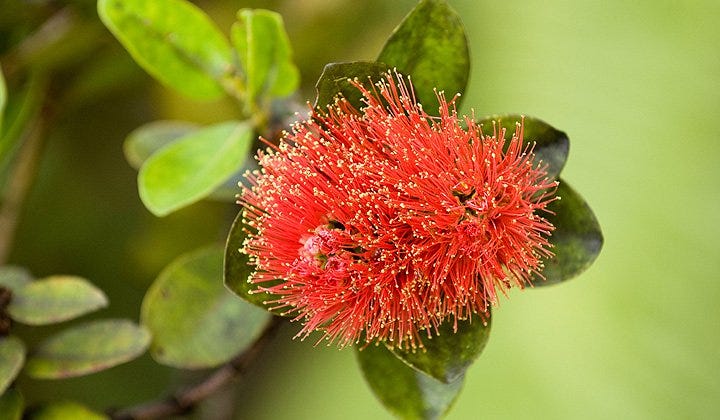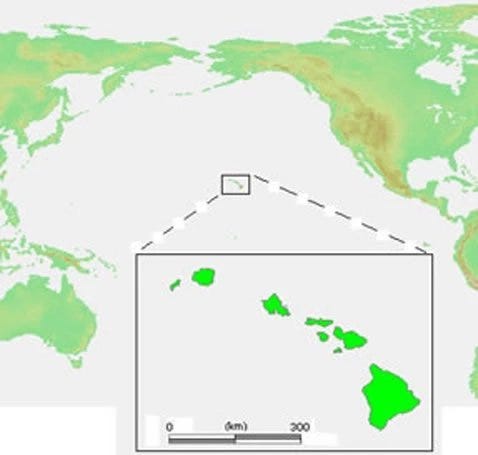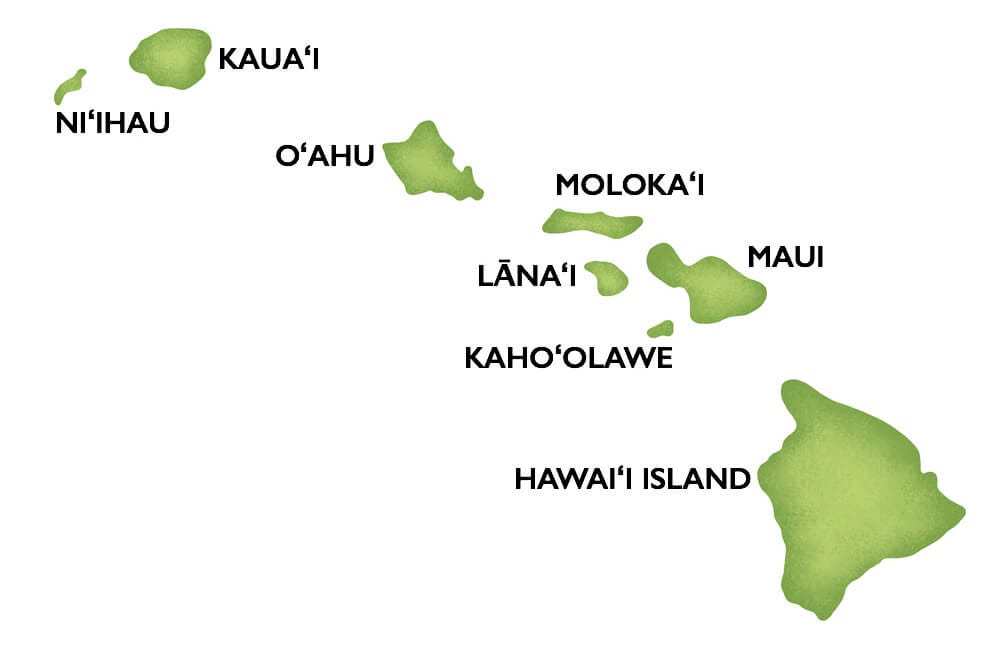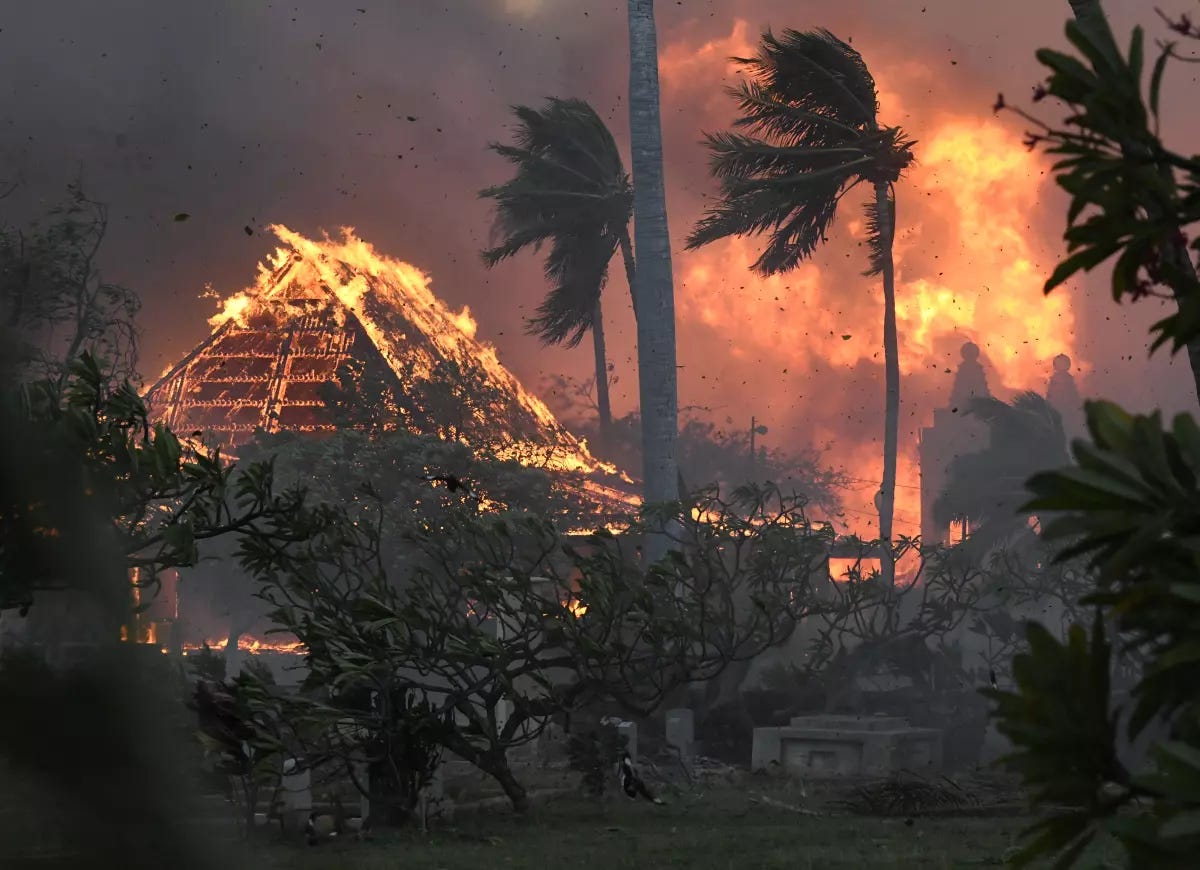The illegal occupation of Hawai'i that continues to this day
The United States annexed Hawai'i for sugar and pineapple plantations and their hegemonic ambitions in Asia.
If you like this article, please don’t hesitate to click like♡ and restack⟳ ! It’s a quick way to make sure more people will get to enjoy it too.
And don’t hesitate to subscribe to my newsletter for free to receive my new articles right in your inbox!

Forgive this short introduction for there is much to cover; Hawai'i’s nature is certainly one of the most beautiful on Earth.
If we want to keep it that way, we must do everything in our power to decolonize the Hawaiian islands that have been under U.S. occupation since 1893.
But let’s start at the beginning with some history as is usual. Let’s talk about the illegal occupation and annexation of Hawai’i.
Hawai'i before colonization
While we should rightly begin where history begins — that is, from the initial Polynesian settlement of the islands to the establishment of the unified Kingdom of Hawai'i in 1795, this is not a history I would be able to transmit, because it is not mine to communicate. I could not do justice to the millennia of Hawaiian history, its language, culture and people. For that, I would instead point you to Indigenous Hawaiian sources to learn more, such as the Ka Mooolelo Hawai'i — the first history of Hawai'i written by Native students in 1838 — or the Papaliko database which hosts a collection of data on historically and culturally significant events, curated by the Office of Hawaiian Affairs. Of course, if you know more Indigenous resources, feel free to post them in the comments for our readers.
Where we will begin instead is shortly before the pivotal event that cemented Hawai'i’s status to the United States: the overthrow of queen Lili'uokalani in 1893.
In January of that year, the queen of the independent and sovereign kingdom of Hawai'i (which had been united by King Kamehameha I in 1795, putting all the islands under one monarch) was overthrown at gunpoint by U.S. Marines. She had ascended to the throne only two years earlier after the untimely death of her brother Kalakaua, and quickly set out to restore power to the monarchy and native Hawaiians with a new constitution after one had been forcefully passed just four years earlier. This effort, however, was quickly opposed by a group of U.S. and European businessmen and lawyers, known as the “Committee of Safety”, who favored annexation with the United States.
We have to understand the context surrounding the United States in 1893 to understand why they were interested in Hawai'i. By that time, most of the territory that now forms the continental United States had been settled and attached to the Union. In 1846, just half a century earlier, settlers stole Texas from Mexico, which led to a war in which Mexico relinquished control of what now forms the southwestern quarter of the United States territory, including California. With this, coast-to-coast hegemony had been achieved.
The following years would be marked by rapid settler expansion to the west, and with it came industrialization — including the building of the transcontinental railroad, completed in 1869 and of which 90% of the workforce was Chinese (on the western portion). They would later be expulsed by the Chinese Exclusion Act of 1882 passed by Congress. In Hawai'i, Chinese immigrants were instead welcomed (alongside Japanese immigrants) by Native Hawaiians, though plantation owners instituted a blanket 10-hour work day on plantations under harsh conditions.
This rapid industrialization didn’t please slaveowners in the south who saw their privileges threatened, and led to a civil war that marked the 1860s. The industrialized Union won, and with it came what is called the Reconstruction era: the final rupture of the slaveowning mode of production that remained in the South and towards a proletarianization of the labor force, which allowed manufacturing to become even more productive.
This laid the final brick towards the American Empire’s hegemonic ambitions, and they could start to look outwards. In 1898, the US declared war against Spain and, in the peace deal, took the Philippines, Cuba, Puerto Rico and Guam — the final colonies of the declining Spanish monarchy.
But the Philippines are far away, especially in the age of the steamboat. To pave the way to Asia, a base of operations was thus required in the Pacific, and Hawai'i was perfectly suited for it. In 1898, President McKinley declared “We must have Hawai'i to get our share of China.”
On top of that, Hawai'i’s climate made it perfect for growing cash crops — prior to annexation, U.S. businessmen had already established large sugar plantations on the island chain. And of course, sordidly, Hawai'i also formed a shield against attacks from the west, seen as recently as the attack on Pearl Harbor in 1941.
All of this leads us to the reasons the USA wanted to annex Hawai'i — whether Hawai'i wanted it or not; and they didn’t.
When queen Lili'uokalani took the throne in 1891, she had her work cut out for her. In 1887, the so-called Bayonet Constitution had been passed in the kingdom, imposed on King Kalākaua on July 6, 1887 by the aforementioned plantation owners. They called themselves the Hawaiian League (despite none of them being Hawaiian) and, through arms, forced the new constitution that they had drafted for the king. This constitution allowed foreign residents to vote — which, to this day, no country offers — and denied over two-thirds of Native Hawaiians from voting.[source]
In 1892, the Legislature of the Kingdom of Hawai'i passed the Highways Act to protect public lands from privatization. Throughout this year, the monarchy was also trying to push forward a new constitution that would undo the Bayonet Constitution.
And, as we’ve seen already, all of this came crashing down in 1893. Shortly after the new year, queen Lili'uokalani made her intentions to push the new constitution clear. Immediately, the Annexation Club — composed of six citizens of the Kingdom (specifically not recorded as being Native Hawaiian) and seven US and European foreigners — carried out their counter-plan: with help from the US government, a fully armed warship anchored in Honolulu harbor (a tactic that the US would use several more times in the future, including in 1974 in Portugal). This move initially scared the legislature who withdrew their support for the new constitution.
While Lili'uokalani tried to ease tensions by walking back some of the changes she wanted to make, it was too late and annexation seemed within reach for plantation owners. On January 16, 162 U.S. sailors and marines landed in Hawai'i and illegally occupied the sovereign and independent nation.
On January 17, the Committee of Safety — the descendent to the Annexation Club — announced martial law and the deposing of the queen. Specifically, they also declared a provisional government until a union with the United States could be achieved.
Whether that was the right move or not, queen Lili'uokalani surrendered to the U.S. government and thus came the end of the long-standing Kingdom of Hawai'i.

What was Hawai'i like before 1893?
Before we continue with this important piece of history, we should take some time to understand what life in Hawai'i was like prior to the coup.
The first fact to clarify is that by 1843, Hawai'i became the first non-Western nation to receive full recognition as an independent state by Western powers. By 1893, the kingdom maintained over ninety consulates and legations (which served the functions of an embassy) worldwide, including in the United States. Only sovereign states maintain embassies abroad to serve as their representatives on foreign soil.
This fact cements that prior to the deposing of the monarchy (and arguably even prior to the Bayonet Constitution), Hawai'i was a fully sovereign nation. Thus, logically, the occupation by U.S. Marines on January 16 was an illegal invasion by a foreign state, and annexation by the U.S. was a coup. This is why we can say that to this day, Hawai'i — being administered by the USA — is a sovereign nation that is illegally occupied.
By the mid-19th century, Hawai'i had achieved a 95% literacy rate, the highest in the world. The Constitutional Monarchy established in 1840 guaranteed equal voting rights regardless of race, gender or wealth — the first of its kind in the modern world; at the time, most Western countries were still limiting voting rights to landowning males, if they had any at all. The constitution came about on the impulse of king Kamehameha III himself (also known as Kauikeaouli), as part of efforts to modernize the kingdom.
In 1859, the Queen’s Hospital was established and provided free healthcare to all native Hawaiians. Electric public lightning came to the streets of Honolulu in 1888 — before even the White House had electric lightning, and becoming one of the first cities in the world to offer it. Laws on land distribution made by the Declaration of Rights (1839) guaranteed virtually no homelessness. Affordable mass-transit made travel between islands possible for everyone.
All of these achievements were instantly reversed after the foreign coup in 1893, which turned Hawai'i into a plantation colony for the United States.
Hawai'i after the coup
Hawai'i became the 50th state of the “Union” in 1959. What happened between 1893 and then?
Immediately after the queen was deposed, a provisional government was set up. This government immediately sent envoys to Washington to seek a treaty of annexation — manifesting their desire for the complete destruction of an independent Hawai'i and into an occupied colony of the United States. The treaty was delayed by the inauguration of Grover Cleveland as US president however, and stalled there. Because of this, the Republic of Hawai'i was proclaimed by the Committee of Safety in 1894. Sanford B. Dole, a white man born in Honolulu, became its president. He was approved for a six-year term and if the name Dole is familiar, it’s because his cousin James D. Dole is the one who started the Dole fruit company (then called the Hawaiian Pineapple Company), which my North American readers are very familiar with. James Dole came to Hawai'i in 1899 and developed the pineapple industry which he had started there in 1851 — pineapple, which is used on “Hawaiian Pizza”, is not native to Hawai'i.
The new constitution accompanying this puppet temporary state required voters to swear allegiance to the republic. Strict property requirements prevented most Hawaiians from voting. The US quickly recognized the coup government (despite president Cleveland publicly criticizing the involvement of U.S. Marines, as is usual).
A counter-rebellion was attempted in 1895 to restore the sovereign kingdom, but failed. In 1898, the situation had stabilized sufficiently that then-president McKinley signed the Newlands Resolution, which annexed Hawai'i to the United States. A petition signed by over half the Hawaiian population was presented to the US government protesting the move, but was ignored.
In 1900, Hawai'i became a territory of the United States — the same status that Puerto Rico, Guam, the Virgin Islands, the Northern Mariana Islands, and ‘American’ Samoa have today. Stanford Dole, previously the president of the coup republic, was named governor of Hawai'i.
At that point, everything that existed under the late constitutional monarchy was broken and rebuilt. There was no more President or king in Hawai'i, but a U.S. governor — and with it, the laws of the occupier came along too, which is illegal under U.N. Occupation Law.
During that time, sugar production expanded from 289,500 short tons in 1900 to 939,300 short tons in 1930 — plantations owned by white Americans and toiled by native Hawaiians. Pineapple grew from 2000 cases in 1903 to 12 million cases in 1931. Tourism, which plagues Hawai'i to this day, started in 1901 with the opening of the Moana hotel. By 1958, tourists amounted to 171 thousand in one year compared to 25 thousand in 1940. All the while, political control remained largely in the hands of the Haole — non-Native Hawaiian, specifically white.
In 1896, the Hawaiian language was banned in public schools — that ban remained in place for 100 years, until 1986. Today, UNESCO still classifies the language as critically endangered.
U.S. businessmen were not the only ones scrambling to the newly-acquired territory, of course. The government immediately set out to fulfill its ambitions and established a dozen military bases in Hawai'i between 1898 and 1922. Since it now considers Hawai'i part of their territory, military presence has only increased, and with it came many scandals and destruction. The military occupies 6% of Hawai'i’s land (illegally), and these bases have displaced many Indigenous Hawaiians and destroyed sacred cultural sites. The U.S. military contributes heavily to environmental crises in Hawai'i, being responsible for example for the Red Hill water contamination crisis.
Hawai'i today

The effects of the colonization of Hawai'i are still felt today because the U.S. government still considers Hawai'i to be their playground for tourism, army and pineapple.
Native Hawaiians face higher rates of poverty compared to whites — 15.4% versus 9.6%. Cost of living soared in Hawai'i with the introduction of a tourism industry (owned by white businessmen); 40% of Indigenous Hawaiian households are cost-burdened by rent prices, meaning they spend more than a third of their income on rent. Indigenous Hawaiians form only 10% of the population of Hawai'i, yet make up 51% of the homeless population. 50% of Native Hawaiians live outside of Hawai'i. The tourism industry pays pittance wages with most of the profits going to the white owners.
More than a quarter of missing girls in Hawai'i are Indigenous, and the average profile of a missing person is a 15-year-old Indigenous girl. Hawai'i has the eight highest rate of missing persons in the United States, and 84% of Indigenous women experience violence in their lifetime. In Operation Keiki Shield, 38% of those arrested for soliciting sex from a 13-year-old online were active-duty U.S. Military personnel. [PDF source]
The tourism industry in Hawai'i has put over 60% of plant an animal species in the ‘endangered’ status, largely due to deforestation to build resorts that make a parody of traditional Hawaiian culture. 44.7% of water on the Big Island (the island of Hawai'i) is consumed by hotels and resorts.
Meanwhile, the U.S. army pollutes potable water through mismanagement and doesn’t clean up the crises. Over several months in 2021, fuel tanks failed one by one at U.S. navy bases at Red Hill (Oahu island) and released tens of thousands gallons of fuel into the water supply on the island of Oahu. The U.S. military control 30% of the land on this island and used it — and its scared cultural site at Kaho’olawe as a bombing range for years. The issue was compounded by the fact that the leaks happened over several months, begging the question as to why the fuel tanks were not inspected and fixed after the first leak. The petroleum contaminated the public water supply for 1 million residents, and the U.S. Navy both refused to help fix the problem and did not notify the authorities when the leaks happened — the problem was reported far too late, when local residents noticed the leak in their tap water. Instead, the Navy ‘promised’ to close the facility by 2027. Today in January 2025, 4,000 gallons of fuel and 28,000 gallons of sludge still remain in the pipes and tanks. Originally, colonial authorities in Hawai'i even said that the water was safe to drink.
Pearl Harbor, which we mentioned at the beginning of this piece, was known as Wai Momi (Pearl Waters) by the Hawaiians, and got its name from the pearl oyster diving trade that took place there. The pristine and shallow waters were perfectly suited for that activity, as well as fishing to feed the population — and they did so faithfully for over 600 years. 27 fishponds lined the shores of the Pearl Waters. In 1887, after the Bayonet Constitution, the U.S. gained exclusive rights to the lagoon as a coaling and repair station and from there built their naval base. Today, the water at Pearl Waters is polluted with arsenic, lead and mercury as brought up in lawsuits.
In the mid-20th century, the U.S. military detonated nuclear weapons as part of tests in the Pacific, not far from Hawai'i. At the Pacific Proving Grounds, Johnston Atoll, Bikini Atoll, and Enewetak Atolls, nuclear bombs were detonated. As part of Operation Fishbowl, a nuclear test was conducted in high-altitude, which caused an artificial aurora visible from Hawai'i and an electromagnetic pulse that damaged electrical infrastructure on the island chain. Over 100 nuclear detonations were made in the Pacific between 1946 and 1962, and the fallout caused — and is still causing — cancers in Hawai'i and other Pacific Islander populations. Residents of Bikini Atoll, which is part of the Marshall Islands chain, still cannot grow food locally.
In 2023, deadly wildfires burned on the island of Maui, becoming one of the deadliest natural disaster in Hawai'i’s history. The fires were caused by sparks from broken power lines that ignited dry vegetation. 102 people were killed by the fires, making it the deadliest U.S. wildfire in history. As of 2025, only three homes have been rebuilt, out of 2,200 structures destroyed. Landlords immediately sensed a good business opportunity, and rent rose by 44% on the island, further displacing Indigenous Hawaiians from their ancestral home. The only help from the federal government was a FEMA loan that will stop in 2028.
In terms of land ownership, The Department of Hawaiian Homelands manages some 200,000 acres to try and distribute to Indigenous Hawaiians, but long waitlists persist. The U.S. Federal government, in comparison, owns 531,000 acres which it uses for military bases and national parks. National Parks in the U.S. (under Roosevelt), as in “Israel”, were mainly established to drive Indigenous tribes away from their homelands — Yellowstone Park, for example, is located on the ancestral homeland to the Shoshone, Bannock, Blackfeet, Crow, and Nez Perce (with evidence of human occupation dating back 11,000 years).
We must also name Mark Zuckerberg (yes, that one) who has been acquiring land on Kauai since 2014. He now holds over 1,400 acres including beachfront and agricultural properties. In 2016, he initiated lawsuits to force owners of kuleana (small parcels with ancestral rights enclosed in ‘his’ property) to sell their stakes, dragging them in expensive lawsuits that the families could not finance. He is not the only one: other U.S. tech figures like Jeff Bezos (Amazon CEO) owns a mansion compound in Hawai'i. Larry Ellison, the Oracle co-founder, owns 98% of Lanai island, one of Hawai'i’s 8 islands. Meanwhile, Indigenous Hawaiians pay $3,000 per month in rent for an average of $18 per hour, which is twice as low as the occupation state’s average wage of $32 per hour.
Again, all of this is technically illegal. Not only under U.S. law, who has signed environmental acts, but also under international law. The U.S. is illegally occupying Hawai'i, an occupation made possibly only by their military might and the putting down of independence movements. In effect, the Kingdom of Hawai'i is under occupation and UN Occupation law applies to it — similarly as it does to Palestine. More and more organizations are recognizing this occupation status, including U.N. bodies, the International Association of Democratic Lawyers and the National Lawyers Guild. Under Occupation Law, the occupied population has the right to resist occupation, including by force.
Like many other countries and territories, Hawai'i is not spared by the effects of ongoing colonization; and all of this is still happening in the 21st century. The only just solution for Hawai'i is the complete expulsion of the U.S. army, the recognition of a sovereign Hawaiian state and nation by the U.S. government, and the relinquishing of its status as a U.S. state or dependency of any kind, and nothing less.
Indigenous Hawaiian groups have been pretty clear about the effects tourism has on their homeland, and have thus have requested (only because they do not have the power to force it) that tourists refrain from visiting Hawai'i — and not just U.S. tourists, but all tourists. I can only echo their voice and make you reconsider visiting Hawai'i as long as it remains a U.S. colony.









Thanks for this informative essay on a modern constitutional republic with 95% literacy displaced for a sugar and pineapple plantation named Dole that occupied the native food and water shed with disease, vulgar tourists, and now climate disasters.
My anger towards that fucking bully of a country called US with its mostly dumb people who allow their govt to wage mass destruction upon other people's as long as they are 'comfortable' has just magnified a thousand folds after reading this greatly informative article (after Gaza genocide, I never thought my anger will ever be increased, I now know I was wrong)
If there truly is any fucking God at all then the US should be obliterated as soon as possible as they are a cancer and plague to this planet since their very beginning. Bunch of fucking filth with weak people who allow their govt get away with virtually anything